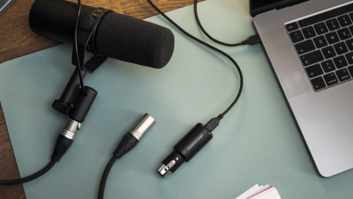(click thumbnail)In radio’s Golden Age, ribbon microphones defined the sound. In the half-century since, dynamic microphones have dominated broadcast booths. The current generation of broadcasters has been reared on a handful of rugged and reliable makes and models. For many, these are the “standard.”
Only a small number of them have opted for condenser mics, which generally are viewed as pricey and less durable despite exceptional sound quality. These microphones have been seen as suited to the more rarified atmosphere of music recording.
Turning tide
A flood of inexpensive condenser mics may change that, however.
A few years back, Shure introduced the KSM line of studio microphones intended for studio recording in the music industry. Its latest entry, the KSM27, is designed for both studio and “live,” or in the field, applications. As such, it can also face radio’s rough-and-tumble.
The KSM27 is cost-effective at $575 retail. It is an externally biased cardioid condenser that comes complete with rubber isolated shock mount.
Product CapsuleThumbs Up
Warm, clean sound
Inexpensive, quality condenser design
High output levels
Thumbs Down
Prone to plosives
Odd layout of low-frequency response switch
Price: $575
For more information, contact Shure in Illinois at (847) 866-2200, or visit www.shure.com on the World Wide Web
Inside, the heart of the mic is a single 1-inch, gold-layered Mylar diaphragm powered by a Class A discrete transformerless preamplifier.
An integrated subsonic filter removes rumble below 17 Hz, while the grille is designed to give pop protection.
Controls include a three-position low-frequency filter to help cut the proximity effect and a 15 dB pad for dealing with extremely high volume situations. Frequency response is rated at 20-20,000 Hz.
Unlike dynamic microphones, which point at you, the side-fire KSM27 stands up in the shock mount. The controls sit in the back while the front faces you. Plugging this into a Behringer MX 602A micromixer, setting levels for this phantom-powered unit was quite different from my usual dynamic.
The output levels for condenser microphones typically are much higher than those for dynamic mics. I did not have to push the preamp on the board to get usable levels. Keeping the board at its comfort zone, combined with the KSM27’s low self-noise (14 dB), made for a quiet combination.
Many studio mics pride themselves on having a flat frequency response. Although that is great for recording instruments, it can put voices in a harsh light.
The KSM27 has a response curve tailored to vocals. Basically, there is a lift at around 3 kHz that tops out between 6 and 7 kHz. Also, the low end has a slight boost that peaks at about 50 Hz. Test recordings revealed a pleasingly warm, vibrant sound.
Shure technicians narrowed these specs down even further for me. The cutoff starts at a much lower frequency, while the rolloff is more gentle and starts at a higher frequency. The response starts to narrow with the low-end cutoff at 18 dB per octave at 80 Hz, then continues to narrow as the low-end is rolled off more gently at 6dB per octave starting a 115 Hz.
A boost that’s a blast
The low-end boost turns into more of a blast with the proximity effect. I prefer to leave the low-frequency filter flat and use the proximity effect for, well, effect. To my ears, the deep cut option on the KSM27 makes for a rather thin sound, albeit canceling the proximity effect.
If you like going this route, the more gentle roll-off option seems to be a nice compromise, especially when working with announcers and/or guests who do not know how to work the proximity effect for emphasis. Oddly, the switch puts the deep cut next to the flat setting. It seems that the mid option should fall between extremes. As it is, this could cause some confusion.
My one major issue with the sound of KSM27 came in handling plosives. The integrated three-stage pop filter was not nearly “pop-proof.”
For professionals who are mindful of proper technique, this is not a problem. But more often than not, a broadcast mic also has to deal with amateurs. Shure does not offer the usual broadcast solution, a foam wind screen/pop filter that mounts directly over the grille. That solution likely would compromise the microphone’s frequency range in pro audio applications. Instead, the company suggests one of those Popper Stopper external screens that can be mounted to the mic boom.
As useful as these screens may be in the recording studio, they have never caught on with broadcasters and are not likely to anytime soon.
The A32SWS windscreen that fits the Shure 44 and 32 mics also works with the KSM27. As it turned out, the third-party foam windscreen from my Electro-Voice RE20 fit fine on the KSM27. It did not noticeably cut the high end from my voice, yet it made the microphone practically impervious to plosives.
Want a shake with that?
The only area where I did not give this microphone the full treatment was in the general mishandling that sometimes happens in stations.
I gave it a good shake and got the sense that it is of sturdy construction and is not overly delicate. I did not, however, give it the drop test that I have seen applied inadvertently and unintentionally at times. According to Shure, the KSM27 goes through the same drop tests as the SM58 to test for durability.
When working in an environment that is actively hostile to equipment, sticking with battle-ready dynamic mics may be right just on general principles. But this condenser should hold up well with anything short of outright abuse.
Apart from the possible need to purchase the accessory foam windscreen, the KSM27 is a fine microphone and a good value. Although it may be hard to get broadcasters to take a chance on anything other than the established “standard” dynamic studio mics, those who try this could set a new standard.








